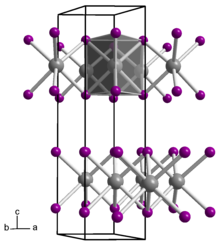Chemistry:Gadolinium diiodide
From HandWiki

| |
| Identifiers | |
|---|---|
3D model (JSmol)
|
|
PubChem CID
|
|
| |
| |
| Properties | |
| GdI2 | |
| Molar mass | 411.06 g·mol−1 |
| Appearance | bronze solid[1] |
Except where otherwise noted, data are given for materials in their standard state (at 25 °C [77 °F], 100 kPa). | |
| Infobox references | |
Gadolinium diiodide is an inorganic compound, with the chemical formula of GdI2. It is an electride, with the ionic formula of Gd3+(I−)2e−,[2] and therefore not a true gadolinium(II) compound. It is ferromagnetic at 276 K with a saturation magnetization of 7.3 B; it exhibits a large negative magnetoresistance (~70%) at 7 T near room temperature.[3] It can be obtained by reacting gadolinium and gadolinium(III) iodide at a high temperature:[4]
- Gd + 2 GdI3 → 3 GdI2
It can react with hydrogen at high temperature (800 °C) to obtain gadolinium hydrogen iodide (GdI2H0.97[5]).[6]
References
- ↑ Haynes, William M. (2012). CRC handbook of chemistry and physics : a ready-reference book of chemical and physical data.. Boca Raton, Fla.: CRC. p. 84. ISBN 978-1-4398-8049-4. OCLC 793213751.
- ↑ Greenwood, Norman N.; Earnshaw, Alan (1997). Chemistry of the Elements (2nd ed.). Butterworth-Heinemann. p. 1240–1242. ISBN 978-0-08-037941-8.
- ↑ K Ahn, C Felser, R Seshadri, R.K Kremer, A Simon (May 2000). "Giant negative magnetoresistance in GdI2" (in en). Journal of Alloys and Compounds 303-304: 252–256. doi:10.1016/S0925-8388(00)00668-X. https://linkinghub.elsevier.com/retrieve/pii/S092583880000668X. Retrieved 2022-07-08.
- ↑ François Nief (2010). "Non-classical divalent lanthanide complexes" (in en). Dalton Transactions 39 (29): 6589–6598. doi:10.1039/c001280g. ISSN 1477-9226. PMID 20631944. http://xlink.rsc.org/?DOI=c001280g. Retrieved 2022-07-08.
- ↑ Michaelis, C.; Mattausch, H.; Simon, A. LnHal2Hn - new phases in the ternary system lanthanide/halogen/hydrogen. II: preparation. Zeitschrift fuer Anorganische und Allgemeine Chemie, 1992. 610: 23-27. ISSN 0044-2313.
- ↑ C. Michaelis, W. Bauhofer, H. Buchkremer-Hermanns, R. K. Kremer, A. Simon, G. J. Miller (December 1992). "LnHal2Hn – Neue Phasen in den ternären Systemen Ln/Hal/H (Ln = Lanthanoid, Hal = Br, I) III. Physikalische Eigenschaften" (in de). Zeitschrift für anorganische und allgemeine Chemie 618 (12): 98–106. doi:10.1002/zaac.19926180118. ISSN 0044-2313. https://onlinelibrary.wiley.com/doi/10.1002/zaac.19926180118. Retrieved 2022-07-08.
| HI | He | ||||||||||||||||
| LiI | BeI2 | BI3 | CI4 | NI3 | I2O4, I2O5, I4O9 |
IF, IF3, IF5, IF7 |
Ne | ||||||||||
| NaI | MgI2 | AlI3 | SiI4 | PI3, P2I4 |
S | ICl, ICl3 |
Ar | ||||||||||
| KI | CaI2 | Sc | TiI4 | VI3 | CrI3 | MnI2 | FeI2 | CoI2 | NiI2 | CuI | ZnI2 | Ga2I6 | GeI2, GeI4 |
AsI3 | Se | IBr | Kr |
| RbI | SrI2 | YI3 | ZrI4 | NbI5 | Mo | Tc | Ru | Rh | Pd | AgI | CdI2 | InI3 | SnI4, SnI2 |
SbI3 | TeI4 | I | Xe |
| CsI | BaI2 | HfI4 | TaI5 | W | Re | Os | Ir | Pt | AuI | Hg2I2, HgI2 |
TlI | PbI2 | BiI3 | Po | AtI | Rn | |
| Fr | RaI2 | Rf | Db | Sg | Bh | Hs | Mt | Ds | Rg | Cn | Nh | Fl | Mc | Lv | Ts | Og | |
| ↓ | |||||||||||||||||
| La | Ce | Pr | Nd | Pm | SmI2 | Eu | Gd | TbI3 | Dy | Ho | Er | Tm | Yb | Lu | |||
| Ac | ThI4 | Pa | UI3, UI4 |
Np | Pu | Am | Cm | Bk | Cf | EsI3 | Fm | Md | No | Lr | |||
 |

